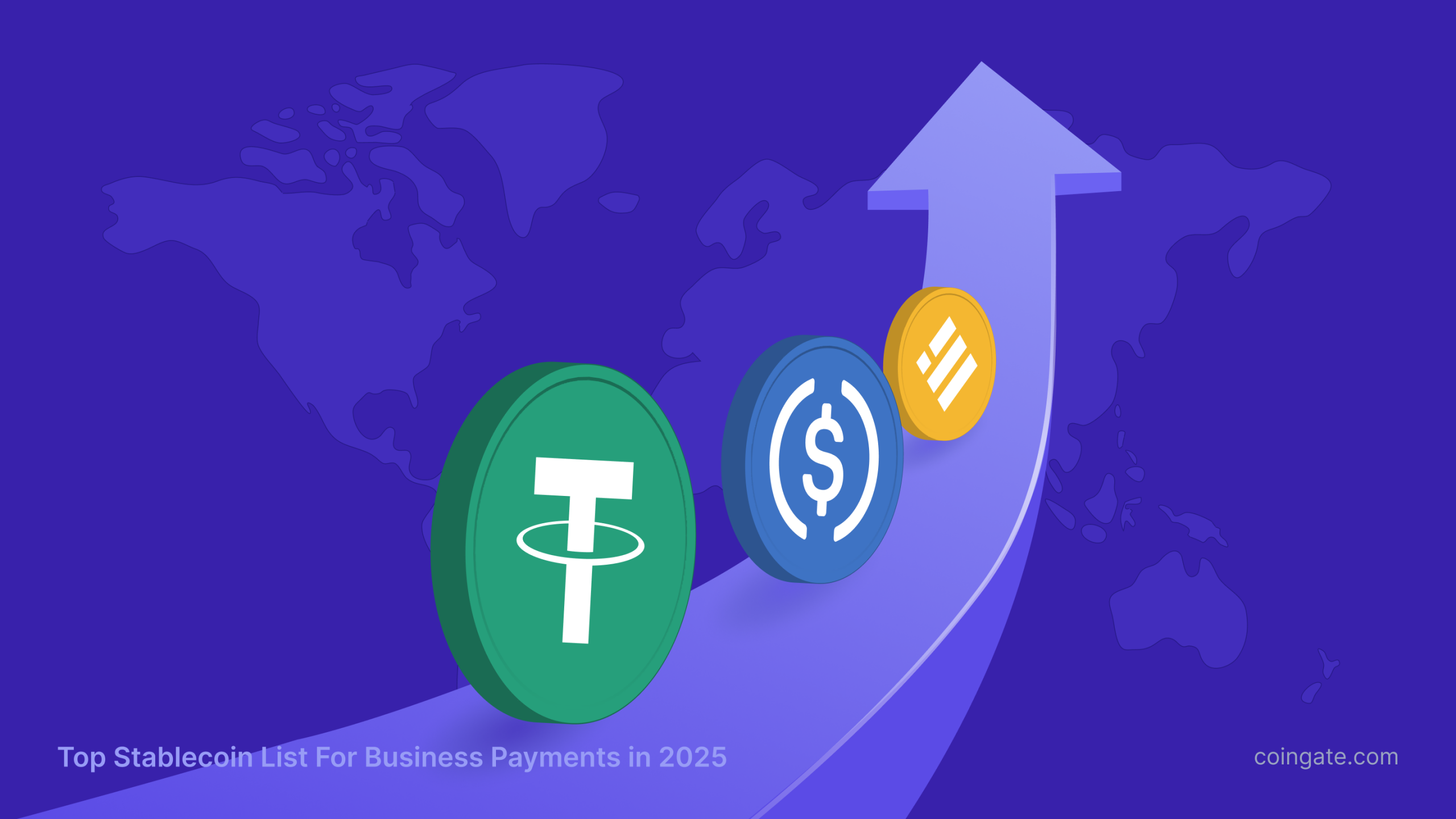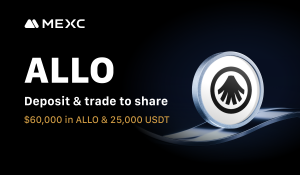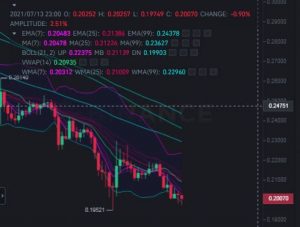Top Stablecoin List for Businesses in 2025
Stablecoins have become essential tools for those looking to utilize blockchain transfers while avoiding the volatility of traditional cryptocurrencies.
By maintaining a stable value, they enable more predictable payments, savings, and transactions, just like the US dollar, but with the ability to exist in the crypto infrastructure.
In this article, we break down the list of stable cryptos that are widely used by businesses and individuals in 2025.
Understanding what stablecoins are will help you choose the right one for your needs, and we hope our complete and structured list will be a valuable guide to picking the best type for your use cases.
Thinking of using stablecoins in your business? Take the first step by creating a CoinGate account.
Most Popular Stablecoins in 2025
USDT, USDC, and DAI lead the stablecoin market in adoption, liquidity, and market cap as of 2025.
USDT remains the most widely used globally, especially in high-volume crypto trading and emerging markets, USDC is favored by businesses for its compliance and reliability, while DAI is a go-to for DeFi applications.
While DAI makes the list as the only algorithmic stablecoin, we can observe a clear dominance of fiat-based cryptos in the market.
USDC is favored by crypto payment solutions for its compliance and reliability, while DAI is the go-to option for working with DeFi applications.
CoinGate supports USDC due to their strong audit trails and decentralization, while discontinuing or limiting support for USDT and DAI.
That’s because they do not meet the new rules imposed by Markets in Crypto-Assets (MiCA), a new regulatory framework from the European Union designed to bring more stability, transparency, and consumer protection to the crypto world.

Read more about it in this article.
Fiat-Backed Stablecoins
Fiat-backed stablecoins are pegged to traditional currencies like the US dollar, and held in bank reserves or equivalent assets. This backing makes them reliable for business transactions because stablecoin units are only minted when an equivalent amount of fiat currency is deposited into the issuer’s reserves, maintaining the 1:1 peg.
Let’s take a closer look at the list of stablecoins with fiat-backed reserves:
- USDT (Tether). The largest stablecoin by market cap, USDT offers wide liquidity across numerous blockchains but has faced scrutiny over its reserves and transparency. Businesses use USDT payments for cross-border transactions, payroll, and treasury management to avoid volatility and eliminate traditional transaction fees.
- USDC (USD Coin). The second largest stablecoin, USDC is known for its transparency with weekly reserve attestations and a backing by cash and short-duration U.S. treasuries. USDC payments are a top choice for businesses working with DeFi platforms that value its emphasis on regulatory compliance.
- BUSD (Binance USD). Issued by Paxos and branded by Binance, BUSD is a popular choice on the Binance exchange and emphasizes regulatory compliance. BUSD is widely used within Binance’s ecosystem for trading and DeFi activities like lending, borrowing, and providing liquidity.
- TUSD (TrueUSD). One of the first regulated stablecoins, TUSD publishes regular attestations, holds its reserves in escrow accounts, and allows token holders to directly redeem TUSD for USD. TUSD is used across exchanges, lending platforms, and payment systems by those who value its transparency.
- PYUSD (PayPal USD). Issued by PayPal in collaboration with Paxos, PYUSD is designed for payments within the PayPal ecosystem and backed by reserves managed by Paxos. PYUSD aims to bridge traditional finance and blockchain payments for both retail and institutional users.
- GUSD (Gemini Dollar). Issued by Gemini, GUSD is a regulated stablecoin that publishes monthly audits and allows direct redemption for USD through Gemini accounts. GUSD is primarily used within the Gemini exchange but is gaining traction in DeFi for lending and staking.
- USDP (Pax Dollar). Formerly known as PAX, USDP is issued by Paxos and was one of the first stablecoins to receive regulatory approval from the New York State Department of Financial Services. USDP is utilized by institutional and retail users for payments, DeFi, and cross-border transactions.

Algorithmic Stablecoins
Algorithmic stablecoins don’t rely on physical reserves. Instead, they use smart contract-based mechanisms to expand or contract supply and maintain a price peg. When the price deviates from the target peg, the protocol automatically increases or decreases supply to bring it back in line.
Without constraints from physical asset holdings, algorithmic stablecoins trade off some of the transparency for greater flexibility for coin supply adjustments. Here is a list of stablecoin options that use algorithmic mechanisms to maintain price stability.
- DAI. DAI is a decentralized stablecoin backed by more crypto than its value, meaning it uses over-collateralization (extra collateral) to safeguard against market drops. DAI payments are widely used in DeFi for lending, borrowing, and yield farming, offering a fully on-chain, transparent alternative to traditional finance.
- USDD. USDD uses smart contracts to automatically adjust its supply based on demand while holding digital assets as backing, a process that ensures its value stays near one USD through decentralized mechanisms. This approach makes it a dynamic stable asset well-suited for decentralized finance, where automated adjustments help maintain price stability.
- FRAX. FRAX combines direct crypto backing (with only a fraction of its supply fully collateralized) with algorithmic supply changes that adjust the number of coins in circulation, ensuring stability even when market conditions vary. This blend of direct collateral and smart, automatic adjustments makes FRAX popular in DeFi for staking, lending, and yield optimization.
- USDe. USDe does not keep traditional fiat reserves; instead, it maintains its dollar peg by using crypto assets as collateral along with automated hedging and algorithmic adjustments to manage supply and risk. This approach makes it particularly suitable for advanced DeFi applications that rely on on-chain automation and seamless integration with digital payment systems.
Commodity-Backed Stablecoins
Commodity-backed Stablecoins are pegged to physical commodities like precious metals, fossil fuels, and even agricultural products. Investors use them to store value during market uncertainty while maintaining blockchain liquidity. These coins combine cryptocurrency benefits with the security of physical assets, which is particularly useful in regions experiencing fiat depreciation.
Let’s look at our top list of stablecoins in 2025 that are backed with physical assets:
- PAXG. PAXG is a gold-backed digital asset where each token represents ownership of physical gold securely stored in vaults. It appeals to investors who want the liquidity of crypto combined with the time-tested value and stability of physical gold, making it a bridge between traditional and decentralized finance.
- XAUt. XAUt is a tokenized form of gold that tracks the price of physical gold, enabling holders to access gold’s value directly on the blockchain. It attracts investors seeking both crypto exposure and the reliability of gold, offering an efficient way to trade and store value in a digital format.
Region-Specific and Ecosystem Stablecoins
Region-specific stablecoins are digital versions of local currencies that work on specific blockchain networks, making it easier for people in particular areas to use digital money without dealing with currency conversion. They combine the stability of familiar local currencies with the speed and efficiency of blockchain technology, making digital transactions more accessible and practical for everyday users.
For more clarity, let’s take a closer look at the list of stablecoins designed for specific ecosystems:
- EURS. EURS is a stablecoin pegged to the euro, providing a digital alternative for those seeking exposure to the European currency. It integrates well into European-focused DeFi platforms, enabling users to make cross-border payments, lending, and liquidity provision with a familiar fiat linkage.
- cUSD. cUSD is a stablecoin native to the Celo network, designed specifically for mobile finance and financial inclusion. It empowers users, especially in emerging markets, by facilitating seamless digital payments and remittances directly through mobile devices while integrating into the Celo ecosystem.
- LUSD. LUSD is a stablecoin from Liquity that allows users to secure interest-free loans against their crypto assets using over-collateralization, ensuring stability through decentralized mechanisms. It is favored in DeFi for its efficient, trustless borrowing framework, appealing to users needing low-cost capital and algorithmically managed value.
- sUSD. sUSD is a synthetic stablecoin from Synthetix that mirrors the value of the U.S. dollar, enabling traders to gain exposure to traditional currencies on-chain. Its integration within the Synthetix ecosystem allows for diversified synthetic asset trading, making it attractive for users who want a blockchain-based route to access fiat-related assets.
- USDX. USDX is a stablecoin developed by Kava, functioning as a decentralized digital dollar ideal for collateralized lending and cross-chain transfers. It serves as a key asset within the Kava network, supporting interoperable financial services and appealing to users requiring stable, digital representations of the U.S. dollar in diverse DeFi applications.
Why Stablecoins Matter in 2025
Stablecoins are now a foundation for global crypto activity. They offer a safe harbor in volatile markets and are increasingly used in cross-border commerce, payroll, and remittances.
In 2025, their influence continues to expand with stronger regulatory frameworks and growing enterprise use.
Because of these benefits, it is not uncommon to see a company implement a crypto payment gateway to incorporate stablecoins as a payment option.
Users value them for their transparency, speed, and cost-efficiency—making them a better option than traditional bank payments. Each list of stablecoin options depicts unique benefits to help companies with their specific use cases.
How to Use Stablecoins for Business in 2025

As we take a closer look at what stablecoins are used for, there is no doubt that crypto integration will only continue to grow. In 2025, there are many businesses enjoying fast settlements, and easy access to global markets without excessive wire transfer fees.
Many companies now integrate stablecoin transactions directly into existing financial and ERP systems to finally switch from traditional banking to blockchain-based payments for payroll, B2B settlements, recurring billing, and treasury operations.
How to Choose the Right Stablecoin for Your Needs
When choosing a stablecoin, users should consider several key factors: trust level, collateral type (fiat, commodity, or algorithmic), regulatory compliance, transaction speed, and platform support. Fiat-backed stablecoins are ideal for users who want stability and regulatory assurance, making them perfect for businesses and traditional financial transactions due to their backing by real-world currencies like the U.S. dollar.
Algorithmic stablecoins are better suited for those involved in decentralized finance (DeFi) who value decentralization and flexibility, as they use smart algorithms to maintain their value without relying on traditional currency reserves.
Commodity-backed stablecoins, such as those backed by gold, offer a way to combine the stability of physical assets with the convenience of digital currency, appealing to investors who need to diversify their assets.
Region-specific stablecoins can provide localized currency solutions, making them useful for users who need to transact in specific regional currencies within their digital ecosystem.
Choosing the wrong stablecoin can impact its usability, speed, and charged fees, so make sure your option ticks all the boxes: quick international transactions, cost-effective savings, B2B settlements, integration with DeFi platforms, digital payment systems, and other features that fit your use cases.
With these benefits, it is not surprising that we are witnessing the growth of platforms that accept stablecoin payments.
Make Stablecoins Work for Your Business with CoinGate
Stablecoins combine crypto efficiency with real-world stability – a perfect combo for businesses looking to modernize their payment infrastructure.
CoinGate payment processing services provide easy integration of stablecoin payments for all companies in USDC and more, with our team working on new additions in the near future.
With cryptocurrencies continuing to reshape the modern business infrastructure our platform makes it easy to integrate stablecoins into your operations.
Whether you need to pay vendors, issue salaries, or settle subscriptions, our platform makes it easy to adopt the blockchain network benefits to your platform.
Sign up now today and level up your business with efficient crypto payment operations.














Post Comment